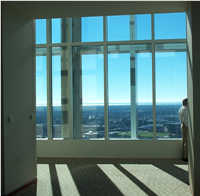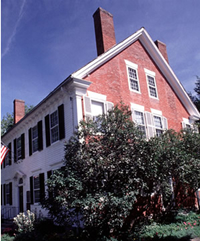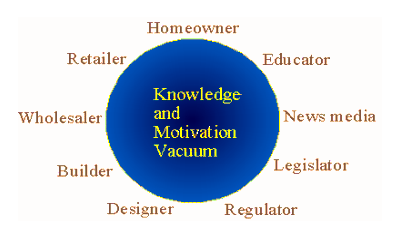
![]()
![]() Modern energy-efficient windows can be tailored for hot or cold climates,
lowering energy bills and increasing comfort and view as well. No longer
are heavily tinted windows or difficult-to-see-through dark window films
needed to provide good energy performance in the south. No longer do northern
residents have to put up with cold and drafty windows and condensation on
the panes or frames.
Modern energy-efficient windows can be tailored for hot or cold climates,
lowering energy bills and increasing comfort and view as well. No longer
are heavily tinted windows or difficult-to-see-through dark window films
needed to provide good energy performance in the south. No longer do northern
residents have to put up with cold and drafty windows and condensation on
the panes or frames.
The new windows incorporate glazing technologies developed in the 80's for northern windows and extended to hot climates in the 90's. In addition to the new spectrally selective glazings, a variety of shading devices is available which are effective at blocking solar heat gain before it reaches the window, and some glass coatings and interior shades reflect radiation back out through the window before it can be absorbed inside.
 The new technologies require new marketing strategies, as homeowners are
confronted with a seemingly bewildering array of choices to make. This web
site has been developed to answer many of your questions and to promote better
understanding of how windows work for and against us and how best to navigate
through the many decisions that often have to be made to optimize the selection
process, window by window through the house.
The new technologies require new marketing strategies, as homeowners are
confronted with a seemingly bewildering array of choices to make. This web
site has been developed to answer many of your questions and to promote better
understanding of how windows work for and against us and how best to navigate
through the many decisions that often have to be made to optimize the selection
process, window by window through the house.
To aid the window industry in understanding the new technologies and the marketing challenges, the Florida Solar Energy Center offers short courses on residential window performance and selection.
 New Technology
New Technology
In recent years, national window manufacturers have greatly expanded the selection of energy efficient and attractive windows, but for many years the focus was on cold northern climates. The so-called "high solar gain low-e" windows developed for those climates are excellent at admitting solar heat, while preventing its escape back outside. This ability of these very well insulated windows to trap heat inside is a boon for northern homeowners.
For sunbelt homes, however, these windows can be a disaster, at least in terms of the discomfort they produce due to localized overheating and sun glare. When they face east or west directions and are unshaded, these cold climate windows excel at capturing the heat of the early morning or late afternoon sun and trapping it inside, making air conditioning bills soar.
New "low solar gain low-e" coatings have been developed that reflect much of the incident solar radiation back outside while still transmitting natural daylight to the interior. These new coatings are ideal for buildings in hot climates and even northern climate ones that are "internal load dominated," meaning that the enclosed volume is large compared with the building envelope's area and that heat from people, lights, and equipment (internal loads) are greater during occupied daytime hours than the heat in or out of the envelope. Such buildings can be overheated even on cold winter days and therefore do not need additional heat gain through the windows.
For detailed information about how these coatings work, see Figure 7 in FSEC's "Industry Guide to Selecting the Best Residential Window Options for the Florida Climate."
For more information about window solar gain and an overview of window coatings, see the section About Solar Gain.
The "Homeowner's Guide to the Selection of the Best Windows for Florida Residences" is intended as a slightly shorter and somewhat easier-to-understand publication describing the basics of windows for hot climates.
The National Fenestration Rating Council includes in its window energy label the parameter which characterizes how much solar gain a window has. The solar heat gain coefficient, or SHGC, is now fully implemented by the NFRC in its national program to rate, certify, and label residential windows sold in the United States.
The other two performance parameters are the U-factor, which tells how much heat a window gains or loses when it is hot or cold outside, respectively, and the annual energy performance rating. The U-factor was the first parameter implemented by the NFRC, because of its importance for windows in cold northern climates. The SHGC is also important in those climates, but it is critical for windows used in hot southern climates. The annual energy performance rating, though well developed technically, won't be applied to NFRC labels until final approvals have been secured within the NFRC.
Solar gain is particularly important in the sunshine state, and NFRC leaders have credited FSEC staff member, Dr. Ross McCluney, former Chairman of the Council's Solar Gain Technical Committee with being instrumental in pushing the SHGC through NFRC's laborious approval process.
Market Expansion
The National Fenestration Rating Council's window energy rating and labeling program is being used by an increasing number of states in the U.S. As the program spreads, it is important to explain the many benefits of high performance windows--to window manufacturers, state energy code officials, builders, architects, and building owners. Without good information, the benefits of these new window options are not likely to be realized.
The new windows offer a "Win Win Win," to building owners and operators, to window sellers, and to the general public.
Win #1: Building owners and operators benefit from improved energy performance and the resulting lowered utility bills, and they often get improved visual, thermal, and acoustic comfort as a bonus. New windows are also available with high impact resistance, providing better protection from hurricane and other storm damage, and which offer excellent energy saving benefits.
Win #2: Window vendors benefit by selling somewhat more expensive windows, and receive an improved profit per window in the process.
Win #3: The public at large benefits from reduced emissions from oil, coal, and natural gas fired electric power plants, and the resulting cleaner air and reduced emissions of what are called "greenhouse gases," gases thought to contribute to global warming. We also benefit from reduced dependence on foreign oil.
Market Problems
In spite of the many benefits of high performance windows, the market for them is not as robust as one might think.

There are many sectors of society having some influence over the selection of windows for buildings. Each of these contributes to what might be called a "circular chain of failure" (depicted in the Figure) reducing the specification and installation of high performance windows. In most cases the failures are due to lack of education and information about the products on the market, on their economic advantages, and on the many benefits of using them. Sometimes the buyer will ask for them, only to find that the window seller doesn't understand either the terminology or the technology, or perhaps just doesn't stock and therefore doesn't often sell the better products. At other times, the seller knows just what is needed and available, but gets so little demand for these better-performing products that they have to be special-ordered, at extra time and expense. Similarly, the market seems biased toward lower first costs, ignoring the substantial energy savings that can be produced by the better products. This aspect of the problem is described in somewhat more detail in the slide show on Economic Justification in the Window Economics section linked from the Nonresidential Options page. The issue is described at greater length in the paper "Justifying Energy Efficient and Renewable Energy Technology" by Dr. Ross McCluney, presented at "Innovation & Application," The 29th Annual Conference of the Solar Energy Society of Canada, Waterloo, Ontario, 21-25 August 2004.
Perhaps we need a more aggressive market restructuring, toward more efficient products. The restructuring can be voluntary, through market incentives, or it can be mandatory, through regulatory means.
The market-based approach - would utilize education, technical information, design assistance, financial incentives to accelerate voluntary adoption of energy efficient building practices.
The regulatory approach - Energy codes are arguably the most cost-effective and permanent mechanism. They are the purest form of market transformation:
- They affect all buildings
- They give clear signals to manufacturers and distributors
- They are persistent
To break the circular chain of failure, public input can be important, through public hearings on energy code modifications and on state and national energy policy revisions, and through consumer demand for improved fenestration products.
